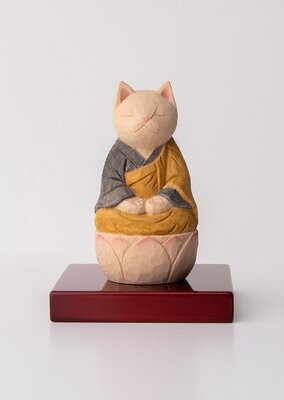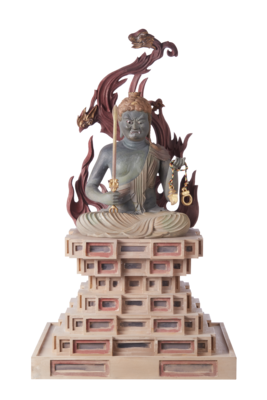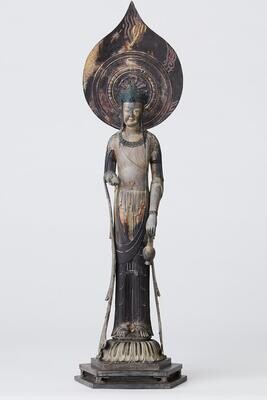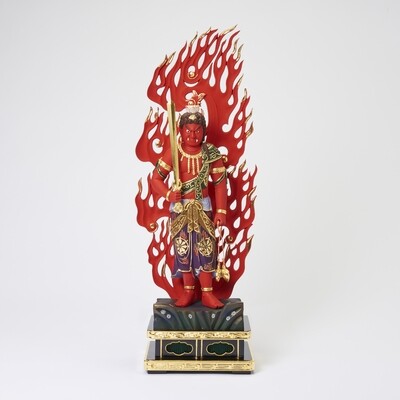Kangi-ten (歓喜天)
This unusually shaped deity has the head of an elephant and the body of a man, and can be depicted as having either one or two bodies. Two common configurations are that of a single bodied deity with the head of an elephant and a dual-bodied god where the two bodies embrace each other. Dual-bodied statues included those with two bodies standing side by side and those with two bodies embracing, symbolic of a man and woman hugging each other. Said to be a strong object of faith, particularly among merchant families, the god assists in gaining wealth and status, marital harmony, in having children, and avoiding the misfortune of sickness.
Kange-ten (歓喜天) is an important bodhisattva in Japanese Buddhism, often translated as the "Bodhisattva of Joyful Deliverance." Kange-ten is particularly revered in Japanese esoteric Buddhism and is considered a symbol of happiness and joy.
Kange-ten is typically depicted as a beautiful female figure holding a sacred jewel (hōju) in her hand. This jewel represents the power to fulfill wishes, and believers often pray to her for happiness and blessings. Her expression is usually serene and filled with happiness, often accompanied by a gentle smile.
One of the key aspects of Kange-ten's worship is the practice of "kisha" (喜捨), which involves acts of charity and giving to others. It is believed that by practicing generosity and helping others, individuals can attain their own happiness and joy. Kange-ten is associated with the idea that joy comes from sharing one's blessings with others.
Additionally, Kange-ten is regarded as the guardian deity of music and dance. Music and dance are considered expressions of happiness and joy, and Kange-ten is believed to appreciate and support these artistic forms. Traditional Japanese performing arts, such as Noh and Kyōgen, often involve prayers and rituals dedicated to Kange-ten to seek success and happiness in the performances.
Kange-ten is widely venerated in Japanese Buddhist temples, particularly those of esoteric Buddhist sects. Many believers offer prayers and devotion to her, seeking happiness, fulfillment of wishes, and joy in their lives. She serves as a role model in Buddhist teachings, inspiring followers to practice kindness, generosity, and compassion towards others.
In summary, Kange-ten plays a significant role in Japanese Buddhism as the Bodhisattva of Joyful Deliverance. She embodies the concepts of happiness, joy, and generosity, and her worship is closely associated with acts of charity and the pursuit of happiness through helping others. Her serene and benevolent presence is deeply integrated into Japan's religious traditions and continues to inspire believers to lead fulfilling and compassionate lives.
- Size: H9×W5.5×D5 (cm), 50g
- Material: Tsuge (柘植)
- Made in China
- You can choose the option to consecrate this statue (give an eye-opening ceremony) before it is shipped from Japan. If you choose this option, we will bring the statue to a Japanese temple, and pay them the necessary fees so that your statue is properly consecrated. The temple will issue a certificate of proof with your name on it, which will also be shipped together with your statue
- Shipped globally from Japan by using DHL. DHL is the world-class shipping services provider who makes international delivery a fast, smooth, and hassle-free experience. Delivery time can be faster than when shopping at an e-commerce website in your country, and of course your package will be covered by insurance. You can check the shipping cost for your entire order before you make a purchase





